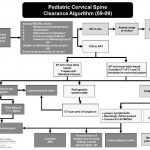In my previous post (click here to view) I discussed an imaging protocol that we developed and implemented last year. Today, I’ll detail what it has accomplished in our patients.
We looked at 229 patients who had their imaging performed according to the new protocol during a 3 month period and compared them to 215 patients who were imaged the previous year. Each scan administered to each body area (head, chest, abdomen/pelvis, c-spine, t-spine, l-spine, face, neck angio) were tabulated separately.
We found that the overall number of scans performed decreased significantly. We looked at our data and generated numbers per 100 patients. During the control period, we did 298 CT scans per 100 patients. This decreased to 271 during the study period. The number of head scans remained the same (82 per 100 patients during control, 85 per 100 during the study), as did the cervical spine scans (84 vs 86).
The biggest declines were seen in chest CT (53 per 100 control vs 33 per 100 study) and abdominal CT (57 vs 43).
We did see an increase in conventional xrays of the thoracic and lumbar spines to offset the absence of reformatted spine images that would have been generated from the chest and abdominal CT scans. We also noted small increases in CT of the head, cervical spine, and neck angio. This was likely due to better adherence to specific guidelines.
Bottom line: we believe that our work shows that careful adoption of well thought out guidelines can make a difference in practice and significantly decreases radiation exposure in our blunt trauma patients.
To read the post on this protocol, or to download it, click here.
Click here to download the Blunt Trauma Radiographic Imaging Protocol Worksheet

